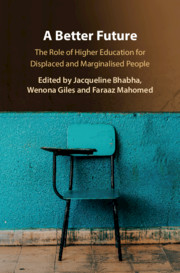Book contents
- A Better Future
- A Better Future
- Copyright page
- Contents
- Figures
- Tables
- Notes on Contributors
- Introduction
- Part I Encountering Marginalisation
- Chapter 1 Disparities in Participation in Higher Education among Migrants
- Chapter 2 Access to Higher Education and Retention of Students with a Migrant Background in the Netherlands
- Chapter 3 Roma in Higher Education
- Chapter 4 Higher Education in Exile
- Chapter 5 Continuing Inequalities in South African Higher Education
- Chapter 6 Inequities in US Higher Education Access and Success
- Chapter 7 Exploring Place
- Part II Deconstructing Marginalisation
- Part III Confronting Marginalisation
- Index
- References
Chapter 3 - Roma in Higher Education
Access Denied
from Part I - Encountering Marginalisation
Published online by Cambridge University Press: 06 September 2020
- A Better Future
- A Better Future
- Copyright page
- Contents
- Figures
- Tables
- Notes on Contributors
- Introduction
- Part I Encountering Marginalisation
- Chapter 1 Disparities in Participation in Higher Education among Migrants
- Chapter 2 Access to Higher Education and Retention of Students with a Migrant Background in the Netherlands
- Chapter 3 Roma in Higher Education
- Chapter 4 Higher Education in Exile
- Chapter 5 Continuing Inequalities in South African Higher Education
- Chapter 6 Inequities in US Higher Education Access and Success
- Chapter 7 Exploring Place
- Part II Deconstructing Marginalisation
- Part III Confronting Marginalisation
- Index
- References
Summary
One in every hundred Romani youth enters higher education in Europe. To justify this educational dearth, policymakers, scholars and practitioners have often reproduced the same racecraft about Roma: they form part of an inferior culture that does not value education. This racist ideology has not only fed a false moral justification but also buried any potential sense of concern and urgency among policymakers regarding the dramatic underrepresentation of Roma in higher education. In this chapter, we argue that public education has historically been an institution designed for gadje (non-Roma) (although less so for gadjo girls and the poor), while Romani children and youth, seen as ‘inferior and nomadic others’, have had no functional option for quality education and even less for higher education. We explore patterns of exclusion, fear, racism and racialised poverty. We show that schools and universities today remain highly unwelcoming for Romani children and youth, failing in large measure to address pervasive structural racism or to advance inclusion and equity. We conclude that education reform needs to start by dismantling the racecraft of ‘inferiority’ from ideology, policies and practice.
- Type
- Chapter
- Information
- A Better FutureThe Role of Higher Education for Displaced and Marginalised People, pp. 59 - 83Publisher: Cambridge University PressPrint publication year: 2020
References
- 3
- Cited by

